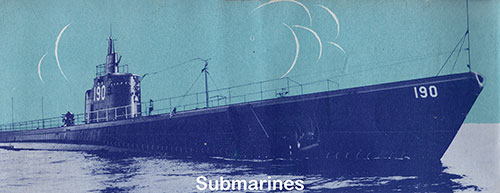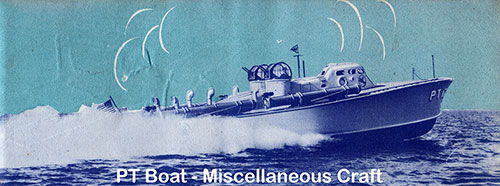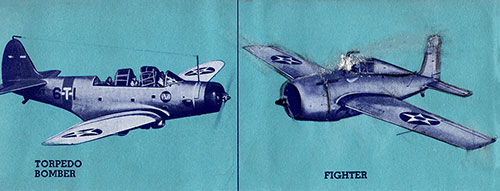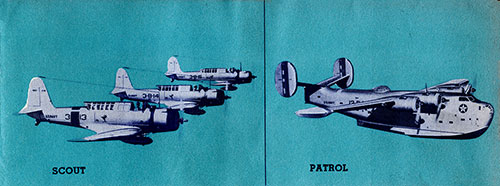The Scouting Force - Our Navy in WW2 - 1945
Planes are today an essential element of Sea Power. Modern Submarines are primarily designed to travel beneath the surface, employed both with the fleet or alone. Auxiliary combat craft includes Torpedo boats, Minelayers, Minesweepers, Gunboats, Patrol Vessels of numerous types, and Submarine Chasers. Torpedo Bomber, Fighter, Scout, and Patrol planes are essential to the US Navy.
SUBMARINES

Submarines. Our Navy, 1945. GGA Image ID # 1d678f4c63
These vessels are primarily designed to travel beneath the surface. They are armed with torpedoes, mines and guns. Submarines can be employed both with the fleet or alone.
In fleet engagements their power may be used on attack against enemy ships. They can lurk beneath the waves and with their deadly torpedoes can sink any ship afloat. They can be employed against commerce—preying on ships carrying vital supplies to the enemy.
Their strictly defensive employment would consist of patrolling our coasts and the planting of mine fields.
The submarine is also an excellent long distance scout. It can get close to enemy ports and shipping lanes without being seen, and report upon movements of the enemy fleet and commerce.
Modern Submarines have a relatively slow surface speed compared to that of other surface craft, with a speed still further reduced when submerged. They are armed with from 6 to 12 torpedo tubes and with a 3-inch or 5-inch deck gun and antiaircraft machine guns.
They carry torpedoes for each tube and from 50 per cent to 100 per cent spares. They have a long cruising range and can operate for several weeks without refueling They are driven by Diesel engines on the surface, by electric storage batteries when submerged.
They can stay under water 24 to 36 hours at a stretch—can submerge to a depth of 250 to 300 feet—and those of average size carry a crew of about fifty-five men.
Experiments have been made in carrying a partially dismantled. or "folding'' airplane on some of the larger submarines. These planes act as scouts to spot the position, direction and speed of enemy vessels—fly back to the submarine and are hauled aboard.
We currently have 105 Submarines, including 68 which are "over-age." Eighty new ones of modern design are being built.
MISCELLANEOUS CRAFT

PT Boats and Other Miscellaneous Craft. Our Navy, 1945. GGA Image ID # 1d67bddd75
The Battleship, Aircraft Carrier, Cruiser, Destroyer and Submarine are the Navy's principal combat types, but there are many other extremely useful vessels, without which no fleet would be complete.
One of the newer types is the motor torpedo boat known as a "Mosquito Boat," used for coastal patrol, convoy work, attacks against larger ships and for general utility work.
They are about 70 feet long—extremely fast, making over 60 knots—mount four torpedo tubes and several machine guns—and are manned by one officer and eight men.
Minelayers have the important task of planting mine fields to protect our coasts, harbors and bases. These boats have special storage spaces for mines and deck tracks and gear for launching them over the stern.
Minesweepers, equipped with special wires and minesweeping gear, clear the path and waters through which our own fleet passes.
Then there are Gunboats, Patrol Vessels of numerous types, Submarine Chasers and many other auxiliary combat craft which are indispensable for harbor protection and coastal patrol.
The Fleet has a large group of noncombatant vessels, each affording certain facilities to keep the fleet ready and fit for action. These include Tenders for Destroyers, Submarines and Aircraft, all of which are capable of performing almost any repair, no matter how great, to the particular type of vessel it serves.
Repair Ships such as operate with the fleet can perform as efficiently as vast machine shops and plants ashore.
Cargo Ships, Store Ships, Oilers and Ammunition Ships supply the fleet with the necessities indicated by their names.
Hospital Ships, equipped with every kind of medical facilities—Transports to use in landing operations—and many other types of Auxiliary vessels are a vital part of our Fleet.
PLANES…The Air Force of the Navy

Torpedo Bomber and Fighter Planes of the US Navy. Our Navy, 1945. | GGA Image ID # 1d67da8878
Planes are today a very essential element of Sea Power. Not only do they act as scouts to determine the location of the enemy, but they are also a powerful attacking force which harasses the enemy ships and destroys or disables them with bombs.
Like the seagoing vessels of the Navy, its airplanes, too, must be of many types, each designed according to the specific function it is to perform. There are four principal categories in the Navy's flying fleet—ship based planes—patrol planes—land based planes and lighter-than-air craft.
Ship Based Planes
The planes operating from Aircraft Carriers may be considered as offensive aircraft—those operating from Cruisers and Battleships as service types. The offensive planes include fighter, torpedo and bombing planes, dive bombers, and carrier scouts.
The fighter's job is to attack enemy aircraft with gun fire, either offensively to gain control of the air, or defensively to protect our own aircraft or surface vessels. The secondary mission of the fighter is to attack exposed enemy personnel with machine guns.
The torpedo and bombing planes are the largest type employed on the carriers. Their primary mission is to attack enemy heavy vessels and shore bases. The torpedo plane carries a torpedo which is dropped when the plane is 100 feet or less above the sea's surface and speeding towards the target. Bombs can of course be dropped from great heights.
The dive bomber, as suggested by its name, delivers its bomb attack at heavy enemy units while in a near vertical dive. These planes can also be used as level-flight bombers, or as scouts.

Scout and Patrol Planes of the US Navy. Our Navy, 1945. GGA Image ID # 1d67e61a4e
The scouting plane requires speed, range, good defensive weapons and excellent facilities for radio in order to accomplish its primary mission of scouting from the carriers.
While the carrier based planes referred to above are operated as land planes (with wheel landing gear), the Scouting and Observation Planes of Cruisers and Battleships must be capable of landing on the water in order to be picked up and returned on beard, and consequently, are either seaplanes or amphibians. They are launched by catapults, and a large crane lifts the planes back on board ship.
Patrol Planes
These are the "flying boats" of the Navy. They are large, multi-motored sea-planes which can stay in the air for 30 or more hours and cover 3,000 to 5,000 miles. They can operate from any fairly sheltered waters—they are equipped with sleeping and living quarters for their crews—they are self-sustaining and self-protecting, to a high degree, while away from their bases on their duty of patrolling vast expanses of the ocean on
the lookout for the enemy.
Land Based Planes
The Navy of course has numerous land based planes at training stations and outlying bases/ These are used for training, transport and general utility purposes.
Lighter Than Air Craft
Non-rigid powered Blimps are extremely useful for coastal patrol work and for anti-submarine duties. Forty-eight of these have been ordered for our new Navy.
There is also some discussion of building a great rigid airship to be equipped as a plane carrier.
